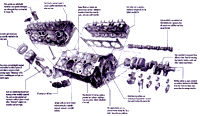TAM Manufacturing plans to continue its efforts under new ownership. Fred Jones Manufacturing of Oklahoma City recently bought the business, although the local management remains in place. The environmental conditions at TAM were well received during a recent audit by the new owner. New corporate support adds engineering muscle and resources to make further improvements in environmental management practices at TAM. And having already obtained a top Q-1 rating from Ford's Quality Program, TAM has just launched work on its ISO 9000 Quality Management Program.
TAM Manufacturing
After World War II, TAM Manufacturing became one of 19 automobile engine remanufacturers franchised by Ford Motor Company in the Pacific Northwest and Alaska. At TAM, automotive and marine engines, and their component parts, are disassembled, cleaned, remanufactured and tested. With 180 employees, and a payroll of $3.5 million, TAM continues a concept first envisioned by Henry Ford in 1942 and carried forth in the finest tradition of environmental stewardship. Remanufacturing is a concept based on waste reduction - it requires 1/20th of the power needed to produce new material.A Fresh Start
The remarkable success of TAM's pollution prevention efforts can be traced to an entirely fresh approach to management brought to the company with the arrival, in 1990, of Ali Kandi, the plant's operations manager. Kandi placed the emphasis on improving sanitation, record keeping and the overall work environment. Another key step included the tracking of chemical handling procedures with simple hand-held monitors. He attributes two key factors as important to the early success: making people aware of the opportunities for improvement and changing people's habits.
Comprehensive Program
Within two years, TAM broadened its commitment to a comprehensive program that included reducing hazardous substance use and waste generation, eliminating extremely hazardous waste, and reducing releases of hazardous substances. Major reductions in waste water volumes were made possible through investments in filtering machines and centrifuges to recycle the water. Replacement of drip tanks with a self-contained baking process reduced wastewater volume by over a hundred-fold. Mopping wastes are now also recycled. These steps have eliminated 250,000 gallons of wastewater per month.
TAM has eliminated the use of methyl ethyl ketone and has eliminated or reduced the use of other solvents. While petroleum naphtha is still used, it now gets completely recycled. Altogether, solvent purchase has been reduced from 1,700 gallons to 450 gallons per month, at sizeable cost savings.
Protecting the environment is a top priority for TAM Manufacturing. The company has adopted an integrated policy where employees participate in various cross-functional teams to implement waste reduction goals and contribute to continuous quality improvement. As a result, TAM has achieved operational efficiencies and has significantly improved its image in the community. Success has in turn enhanced its employee morale and customer satisfaction.